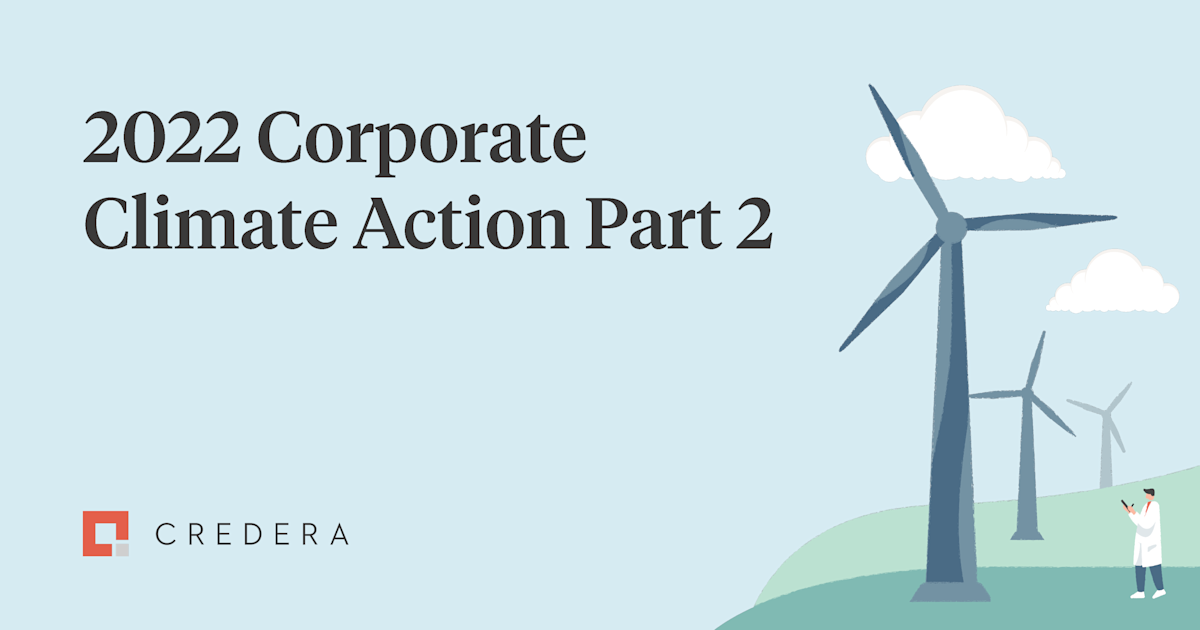Strategy
Nov 16, 2022
A Look at Corporate Climate Action in 2022 Part 2: Taking a Look Under the Hood

This is part two of our “A Look at Corporate Climate Action” series. Find part one here.
Until reporting regulations go into effect in the U.S., climate disclosures and actions will continue to vary significantly from company to company. Taylor Francis, cofounder of a leading carbon tracking startup states, “Not every zero-carbon pledge is equal.”
The 2022 Corporate Climate Responsibility Monitor (the Monitor) analyzed the top 25 global companies (determined by annual revenue) and these companies account for about 5% of total greenhouse gas (GHG) emissions. Yes, you read that correctly. As few as 25 companies can make a significant difference. For more information, see this report. All 25 companies have some sort of zero-emission, net-zero, or carbon neutrality target, yet the report calculates that they collectively commit to reducing only 20% of their 2.7 gigatonnes of CO2 equivalent (GtCO2e) emission footprint by their respective target years. Unsurprisingly then, the report concludes that 2030 targets fall well short of the ambition required to meet the Paris Agreement goal of capping average global temperature rise at 1.5° C.
One common shortfall of corporate net-zero targets according to the Monitor is excluding scope 3 (upstream and downstream) emissions from reduction targets or not providing detail about how they will reduce these emissions. This is concerning because scope 3 emissions account for 87% of total emissions in the companies assessed. At least five of the companies committed to reducing emissions by less than 15%, often by excluding scope 3 emissions, and only eight of the 25 disclosed a moderate level of detail on their plans to address scope 3 emissions.
Interlude About Scope 3 Emissions
While it’s true that scope 3 emissions are important, in reality corporate shortfalls in tracking and reducing scope 3 emissions may be more due to the “fool’s errand” nature of the task rather than suspicious neglect. In a Harvard Business Review article that proposes an alternative to scope 3 emissions tracking, Robert Kaplan and Karthik Ramanna state, “The difficulty of tracking emissions from multiple suppliers and customers across multi-tier value chains makes it virtually impossible for a company to reliably estimate its scope 3 numbers.” Kaplan and Ramanna claim that estimating all upstream and downstream emissions “introduces high measurement error, opening the door to bias and manipulation.”
Growing Climate Industry
It is encouraging that more and more companies are adopting corporate climate programs. The rapid adoption of corporate climate programs is opening an entire industry of support to help companies make the sustainable transition—from helping companies stay on top of emerging science and regulatory policies to those designing and standing up the data and systems architecture to accurately track and reduce emissions.
For example, Salesforce now offers Net-Zero-as-a-Service software, Microsoft recently released its own Sustainability Cloud, and numerous startups (e.g., Watershed, Persefoni, Sinai Technologies, Planetly) have entered the space hoping to solve tough carbon-related problems for clients.
Looking Forward at Climate Action
As Hilary Vogelbaum pointed out, there’s a million different ways you can look at the current state of affairs with regards to combating climate change. In this vein, Hilary said at one point in our interview, “It seems like everyone claims 40% of emissions come from something, whether it’s cows burping, cars, mining, etc.” Research and data are not yet conclusive on whether global corporations and governments will achieve true net zero emissions. But what is becoming clear is that we are not currently on track to limit global temperature rise to 1.5° C, even if those with climate commitments are actually able to deliver on them.
Still, there is hope because:
Climate risk is financial risk, which is likely to spur action.
Significant concentrations of power exist and when they collectively respond to the financial risk, they will be a catalyst for rapid deployment of widespread solutions.
Looking Forward
Credera is committed to making an impact on environmental sustainability by helping our clients navigate carbon accounting challenges in their business and by partnering with organizations in our communities.
If you’re interested in learning more about our environmental sustainability efforts, visit our CredClimate page. Or if you’re interested in working at a place where team members are encouraged to pursue what they’re passionate about, check out our open roles on Credera's jobs page.
Contact Us
Let's talk!
We're ready to help turn your biggest challenges into your biggest advantages.
Searching for a new career?
View job openings






